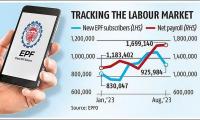India Unemployment Rate Dips to 6.4% in Q2 FY25: Survey
India's unemployment rate in urban areas dropped to 6.4% in the July-September quarter, according to the National Sample Survey Survey (NSSO). Learn more about the labor force participation rate and other key insights.

Illustration: Uttam Ghosh/Rediff.com
New Delhi, Nov 18 (PTI) The unemployment rate for people aged 15 years and above in urban areas dipped to 6.4 per cent in the July-September quarter, according to the National Sample Survey Survey (NSSO).
Joblessness, or unemployment rate, is defined as the percentage of unemployed people in the labour force.
The unemployment rate in the September quarter of FY24 was 6.6 per cent.
The unemployment rate for people aged 15 years and above in the previous April-June quarter of FY25 was 6.6 per cent in urban areas, the 24th Periodic Labour Force Survey (PLFS) showed.
The unemployment rate among females (aged 15 years and above) in urban areas declined to 8.4 per cent in July-September 2024 from 8.6 per cent in the same quarter a year ago. The rate was 9 per cent in April-June, 2024.
Among males, the unemployment rate in urban areas declined to 5.7 per cent in July-September 2024 from 6 per cent in the same quarter a year ago. The rate was 5.8 per cent in April-June 2024.
Labour force participation rate in Current Weekly Status (CWS) in urban areas for people aged 15 years and above increased to 50.4 per cent in July-September from 49.3 per cent in the same quarter a year ago. The rate was 50.1 per cent in the April-June 2024.
Labour force refers to the part of the population, which supplies or offers to supply labour for pursuing economic activities for the production of goods and services and, therefore, includes both employed and unemployed persons.
The NSSO had launched PLFS in April 2017.
On the basis of PLFS, a quarterly bulletin is brought out giving estimates of labour force indicators namely unemployment rate, worker population ratio (WPR), labour force participation rate (LFPR), distribution of workers by broad status in employment and industry of work in CWS.
The estimates of unemployed persons in CWS give an average picture of unemployment in a short span of seven days during the survey period.
In the CWS approach, a person is considered unemployed if he/she did not work even for one hour on any day during the week but sought or was available for work at least for one hour on any day during the period.
Labour force, according to CWS, is the number of persons either employed or unemployed on average in a week preceding the date of the survey. LFPR is defined as the percentage of the population in the labour force.
Joblessness, or unemployment rate, is defined as the percentage of unemployed people in the labour force.
The unemployment rate in the September quarter of FY24 was 6.6 per cent.
The unemployment rate for people aged 15 years and above in the previous April-June quarter of FY25 was 6.6 per cent in urban areas, the 24th Periodic Labour Force Survey (PLFS) showed.
The unemployment rate among females (aged 15 years and above) in urban areas declined to 8.4 per cent in July-September 2024 from 8.6 per cent in the same quarter a year ago. The rate was 9 per cent in April-June, 2024.
Among males, the unemployment rate in urban areas declined to 5.7 per cent in July-September 2024 from 6 per cent in the same quarter a year ago. The rate was 5.8 per cent in April-June 2024.
Labour force participation rate in Current Weekly Status (CWS) in urban areas for people aged 15 years and above increased to 50.4 per cent in July-September from 49.3 per cent in the same quarter a year ago. The rate was 50.1 per cent in the April-June 2024.
Labour force refers to the part of the population, which supplies or offers to supply labour for pursuing economic activities for the production of goods and services and, therefore, includes both employed and unemployed persons.
The NSSO had launched PLFS in April 2017.
On the basis of PLFS, a quarterly bulletin is brought out giving estimates of labour force indicators namely unemployment rate, worker population ratio (WPR), labour force participation rate (LFPR), distribution of workers by broad status in employment and industry of work in CWS.
The estimates of unemployed persons in CWS give an average picture of unemployment in a short span of seven days during the survey period.
In the CWS approach, a person is considered unemployed if he/she did not work even for one hour on any day during the week but sought or was available for work at least for one hour on any day during the period.
Labour force, according to CWS, is the number of persons either employed or unemployed on average in a week preceding the date of the survey. LFPR is defined as the percentage of the population in the labour force.
You May Like To Read
TODAY'S MOST TRADED COMPANIES
- Company Name
- Price
- Volume
- Vodafone-Idea-L
- 11.65 (+ 3.56)
- 106772451
- Alstone-Textiles
- 0.28 ( -3.45)
- 44187760
- Mangalam-Industrial
- 0.88 ( -2.22)
- 39177573
- Sunshine-Capital
- 0.27 (+ 3.85)
- 35956340
- GMR-Airports
- 104.40 (+ 6.37)
- 30453005





